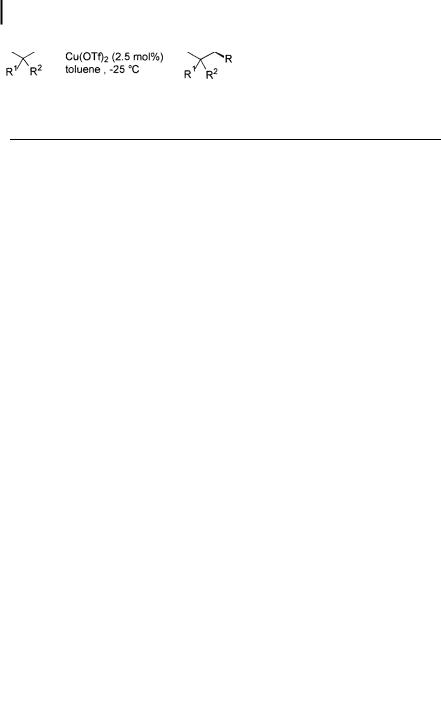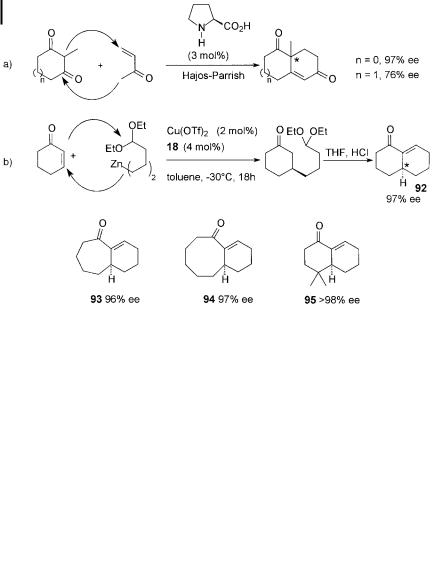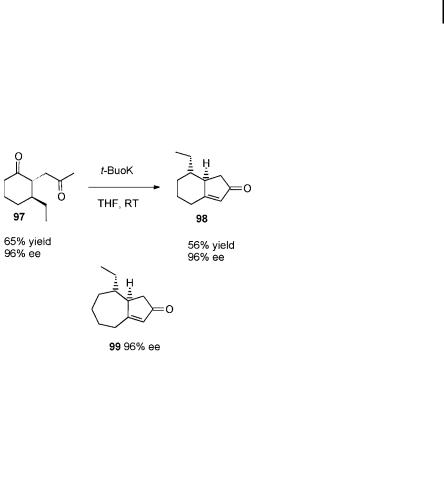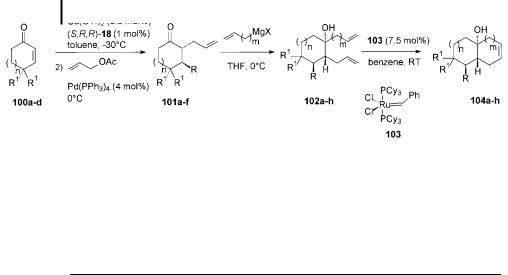
Modern Organocopper Chemistry
.pdf
2487 Copper-catalyzed Enantioselective Conjugate Addition Reactions of Organozinc Reagents
Tab. 7.4. Conjugate additions to 2,5-cyclohexadienone monoacetals and ethers.
R1 |
R2 |
R |
Yield (%) |
dr |
ee (%) |
OMe |
OMe |
Et |
65 |
— |
97 |
OEt |
OEt |
Et |
59 |
— |
92 |
aOCH2CH2Oa |
Et |
68 |
— |
92 |
|
aOCH2CH2CH2Oa |
Et |
62 |
— |
89 |
|
aOCH2C(Me)2CH2Oa |
Et |
75 |
— |
85 |
|
OMe |
OMe |
Me |
76 |
— |
99 |
OMe |
Me |
Et |
60 |
90/10 |
97a) |
OMe |
CH2Ph |
Et |
53 |
97/3 |
93a) |
aCH2CH2CH2Oa |
Et |
66 |
99/1 |
65a) |
|
OMe |
OCH2Ph |
Et |
58 |
1/1 |
98/98 |
a)The ee for the major diastereoisomer is given
ligand 18 can indeed readily distinguish the Re and Si faces and the pro-R and pro- S positions in the dienone. It was found with 64 that the C-5 alkyl group was introduced syn to the alkoxy moiety. The selectivity again depended on the substituents at the 4-position, with ees of up to 97% and ratios of up to 99:1 being found for the major diastereoisomer of 65.
The products of this catalytic enantioselective 1,4-addition still contain an enone moiety, prone to subsequent 1,4-addition [73]. An intriguing question regarding stereocontrol was posed; would the stereoselectivity in the second addition step be governed by the catalyst or would there be a major e ect from the stereocenters already present? Sequential 1,4-addition to dimethoxy-substituted cyclohexadienone 66 (Scheme 7.18) using the copper catalyst based on ðS; R; RÞ-ligand 18 both in the
Scheme 7.18. Selective cis or trans double conjugate addition of Et2Zn to cyclohexadienone monoacetal 66.

7.4 Synthetic Applications 249
first step (97% ee) and in the second gave a 96% selectivity for trans-3,5-diethyl-4,4- dimethoxycyclohexanone (68). In contrast, use of ðS; R; RÞ-ligand 18 followed by ðR; S; SÞ-18 resulted in (meso)-cis-69 (95% selectivity).
In the case of 2,5-cyclohexadienone 70, with a methoxy and a methyl substituent (Scheme 7.19), the syn monoadduct 71 gave 3,4,4,5-tetrasubstituted cyclohexanones, with three consecutive stereocenters. On employing the ðR; S; SÞ-ligand 18 in the second addition step, cis-72 (98% de) was found, whereas with ðS; R; RÞ-18 in the second step trans-73 (98% de) was obtained [73].
Scheme 7.19. Selective cis or trans double conjugate addition of Et2Zn to cyclohexadienone ether 70.
The lack of any directing e ect from the 4-methoxy and the 5-ethyl substituents at the two stereocenters already present in 71 is a remarkable finding, and points to strong catalyst-dependence in the stereocontrol (Scheme 7.20). On the basis of these findings, various stereoisomers of 3,4,4,5-tetrasubstituted cyclohexanones are now accessible through sequential catalytic 1,4-additions, with control over the relative and absolute configurations possible simply by judicious selection of the appropriate enantiomer of the chiral ligand in each step.
Scheme 7.20. The selectivity of the second conjugate addition depends solely on the configuration of the chiral catalyst used.

2507 Copper-catalyzed Enantioselective Conjugate Addition Reactions of Organozinc Reagents
7.4.4
Lactones
Unsaturated lactone 74 (Scheme 7.21) can be viewed as an oxygen heterocyclic analogue of 2-cyclohexenone, and it has recently been reported that catalytic 1,4- additions of Et2Zn to 74 can indeed be accomplished with high enantioselectivity. For adduct 76, Reetz achieved a remarkable 98% ee when employing ferrocenebased diphosphonate ligand 23 [48]. Using diphosphite 24, Chan et al. achieved an ee of 92% for the six-membered lactone 74 and a 56% ee for the five-membered lactone 25 [49c].
Scheme 7.21. Enantioselective conjugate addition to lactones.
7.4.5
Nitroalkenes
Nitroalkenes are excellent Michael acceptors, and asymmetric 1,4-additions to nitroalkenes (Scheme 7.22) provide access to highly versatile synthons, since the nitro group is readily reduced to the corresponding amine [74]. Seebach, employing a
Scheme 7.22. Enantioselective conjugate addition to nitroalkenes.

7.4 Synthetic Applications 251
stoichiometric chiral TADDOL-based titanium Lewis acid, reported highly enantioselective 1,4-additions of R2Zn reagents to nitrostyrenes (90% ee) [75]. The first copper-catalyzed enantioselective 1,4-additions of Et2Zn to nitroalkenes 78 and 79, with ees of up to 86%, were described by Sewald et al. (Scheme 7.22) [76].
Alexakis, employing various chiral trivalent phosphorus ligands, has recently described Cu(OTf )2-catalyzed 1,4-additions of Et2Zn to a number of nitroalkenes (Scheme 7.22) [77]. TADDOL-based phosphonite 82 gave the highest ees for arylnitroalkenes (up to 86%), whereas phosphoramidite 18 is the ligand of choice for alkylnitroalkenes (ees of up to 94%).
We have studied the Cu(OTf )2-phosphoramidite-catalyzed conjugate addition of Et2Zn to a; b-unsaturated nitroacetate 87 (Scheme 7.23) [78, 79]. The nitroacetate moiety is a synthetic equivalent of an a-amino acid, and reduction of the nitro group in the 1,4-adduct provides access to a- and b-alkylated amino acids. Although the 1,4-adduct 88 is obtained in high yield, the enantioselectivity has so far been disappointingly low (26% ee) when using a mixture of E and Z isomers of the nitroalkene. With isomerically pure (Z )-87, a complete lack of enantioselectivity was observed, suggesting that a cis orientation of aryl and nitro groups is unfavorable for the selective formation of the catalyst-substrate complex.
Scheme 7.23. Enantioselective conjugate addition to a; b-unsaturated nitroacetates 87.
Correspondingly, the catalytic 1,4-addition of dialkylzinc reagents to 3-nitro- coumarin 89 (Scheme 7.24), with a fixed trans orientation of the aryl and nitro groups, proceeds with excellent yields (90–99%), high diastereoselectivity (d.r. up to 20:1), and enantioselectivities of up to 92%. Hydrolysis of the lactone moiety in 90 was accompanied by decarboxylation, providing an asymmetric synthesis of b-aryl- nitroalkane 91.
Scheme 7.24. Enantioselective conjugate addition to 3-nitrocoumarin (89).

2527 Copper-catalyzed Enantioselective Conjugate Addition Reactions of Organozinc Reagents
7.4.6
Annulation Methodology
The construction of carbocyclic compounds by ring-annulation procedures frequently plays a prominent role in total synthesis. The tolerance of various functional groups in the zinc reagents employed in copper-catalyzed asymmetric 1,4- additions forms the basis for three novel catalytic enantioselective annulation methods discussed here.
In the first method, a dialkylzinc reagent bearing an acetal moiety at the d-posi- tion is used (Scheme 7.25(b)). The catalytic 1,4-addition is followed by acetal hydrolysis and aldol cyclization of the 4-substituted cycloalkanone, a ording 6,6- (92), 6,7-, (93) and 6,8- (94) annulated ring systems with high enantioselectivities (> 96% ees) [80]. In addition, dimethyl-substituted decalone 95, with a structure frequently found in natural products, is readily obtained in enantiomerically pure form.
Scheme 7.25. Annulation methodology : a) Hajosh–Parrish version of the Robinson annulation, b) catalytic enantioselective annulation with functionalised organozinc reagents.
Comparison with the Hajos–Parrish asymmetric version of the Robinson annulation [81] (Scheme 7.25(a)) shows the following distinct di erences between the two methods. Firstly, the cycloalkenone in the Cu(OTf )2/ligand 18-catalyzed procedure is the Michael acceptor, whereas the cycloalkanone is the Michael donor in the proline-mediated annulation. Secondly, the asymmetric induction occurs in the 1,4-addition step in the new method, in contrast to the asymmetric aldol-cyclization in the Hajos–Parrish procedure.

7.4 Synthetic Applications 253
Bicyclo[4.3.0]nonenes, thanks to their frequent appearance in natural products, are other important targets for novel annulation methodology. A six-membered ring-annulation to cyclopentenones has yet to be developed, the main reason for this being that, until very recently, the levels of enantioselectivity in catalytic 1,4- additions to 2-cyclopentenone were too low for a synthetically useful procedure. However, a highly enantioselective annulation of a five-membered ring to 2-cyclo- hexenone has been developed (Scheme 7.26) [80].
Scheme 7.26. Catalytic enantioselective annulations of five-membered rings.
The method involves a regioselective, trans-diastereoselective, and enantioselective three-component coupling, as shown in Scheme 7.26. In this case, the zinc enolate resulting from the 1,4-addition is trapped in a palladium-catalyzed allylation [64] to a ord trans-2,3-disubstituted cyclohexanone 96. Subsequent palladiumcatalyzed Wacker oxidation [82] yields the methylketone 97, which in the presence of t-BuOK undergoes an aldol cyclization. This catalytic sequence provides the 5,6- (98) and 5,7- (99) annulated structures with ees of 96%.
The third annulation method is again based on asymmetric tandem 1,4-addition and palladium-catalyzed allylation [83]. The key step is a ring-closing metathesis using Grubbs’ catalyst 103 (Scheme 7.27). Advantage is taken of the presence of the ketone moiety in the adduct 101, which permits a subsequent 1,2-addition of a Grignard or organolithium reagent. In this way a second alkene moiety is introduced. Ring-closing metathesis of 102 a ords the bicyclic structures 104. A wide

254 7 Copper-catalyzed Enantioselective Conjugate Addition Reactions of Organozinc Reagents
Scheme 7.27. Catalytic enantioselective annulations using RCM (ring-closing metathesis).
variety of annulated ring systems is accessible through this catalytic methodology (Table 7.5).
Tab. 7.5. Enantioselective annulations using RCM.
R |
R1 |
n |
m |
Product |
Ring system |
Yield a) (%) |
ee (%) |
Et |
H |
1 |
1 |
104a |
[6, 6] |
49 |
96 |
Et |
H |
2 |
1 |
104b |
[7, 6] |
58 |
96 |
Et |
H |
3 |
1 |
104c |
[8, 6] |
32 |
97 |
Et |
Me |
1 |
1 |
104d |
[6, 6] |
45 |
97 |
Me |
H |
1 |
1 |
104e |
[6, 6] |
34 |
96 |
Bu |
H |
1 |
1 |
104f |
[6, 6] |
52 |
93 |
Et |
H |
1 |
0 |
104g |
[6, 5] |
—b) |
— |
Et |
H |
1 |
2 |
104h |
[6, 7] |
56 |
96 |
|
|
|
|
|
|
|
|
a)Isolated yield over three steps of all-trans isomer.
b)Only a small amount (< 10%) of cis-fused 104g was detected by GC.
Very recently, a catalytic enantioselective route to prostaglandin E1 methyl ester was developed based on a tandem 1,4-addition-aldol reaction [84].
7.5
Conclusions
Organozinc reagents have played an important role in the development of e cient catalysts for enantioselective carbon–carbon bond-formation by 1,4-addition to a; b- unsaturated compounds. Important advantages of the use of organozinc reagents are the option of starting with alkenes (through hydroboration-zinc transfer procedures) and the tolerance towards functional groups.
The use of copper catalysts based on chiral phosphorus ligands to assist 1,4- additions of dialkylzinc reagents has in recent years produced major breakthroughs, with excellent enantioselectivities. A number of monodentate and bidentate phosphoramidites, phosphites, phosphonites, and phosphines are now available as chiral ligands for alkyl transfer to a variety of cyclic and acyclic enones. So far,

References and Notes 255
excellent stereocontrol has proven especially attainable in alkyl transfer to various cyclic enones. The modular structures of most of these chiral phosphorus ligands should be highly beneficial for the future fine-tuning of the catalysts to deliver high enantioselectivities for specific classes of substrates.
A few catalysts display activity and selectivity levels su ciently high for application in organic synthesis. Their utilization in the synthesis of a number of chiral building blocks and target molecules is emerging as summarized in the second part of this chapter.
For the transfer of aryl and alkenyl groups to enones, Hayashi’s procedure, employing the corresponding boronic acids and a rhodium-BINAP catalyst, is the method of choice at present [24, 25]. For the transfer of alkyl groups to cyclic enones the use of dialkylzinc reagents in the presence of copper-phosphoramidite catalysts is superior. Although the first examples of highly enantioselective 1,4-ad- ditions of R2Zn reagents to nitroalkenes have been reported, similar catalytic methods for numerous other classes of a; b-unsaturated compounds still need to be developed.
Furthermore, the recent successes with R2Zn reagents should certainly stimulate new investigations into enantioselective 1,4-additions of Grignard and organolithium reagents. The elucidation of the mechanisms and the factors governing stereocontrol in these catalytic systems are other major challenges for the near future.
Acknowledgements
We are grateful to the co-workers who participated in the studies summarized in this chapter; their names are given in the references. We thank Ing. Marc van Gelder for his contributions with numerous HPLC and GC separations and Dr. A. J. Minnaard for suggestions and discussions. Financial support from The Netherlands Foundation for Scientific Research and from the European Community is gratefully acknowledged.
References and Notes
1 |
Comprehensive Organic Synthesis, |
4 |
a) Organocopper Reagents, A Practical |
|
B. M. Trost, I. Fleming (Eds.), |
|
Approach, R. J. K. Taylor (Ed.), |
|
Pergamon, Oxford, 1991, Vol. 4. |
|
Oxford University press, Oxford, 1994; |
2 |
P. Perlmutter, Conjugate Addition |
|
b) B. H. Lipshutz in Organo- |
|
Reactions in Organic Synthesis, |
|
metallics in Synthesis, M. Schlosser |
|
Pergamon Press, Oxford, 1992. |
|
(Ed.), Wiley, Chichester, 1994; c) B. H. |
3 |
a) M. Shibasaki, H. Sasai, T. Arai, |
|
Lipshutz, Acc. Chem. Res. 1997, 30, |
|
Angew. Chem. 1997, 109, 1290; Angew. |
|
277. |
|
Chem. Int. Ed. 1997, 36, 1236; b) J. |
5 |
a) M. Kumada, Pure Appl. Chem. 1980, |
|
Leonard, Contemp. Org. Synth. 1994, |
|
52, 669; b) E. Negishi, Acc. Chem. |
|
1, 387. |
|
Res. 1982, 15, 340; c) D. Seebach, L. |

256 7 Copper-catalyzed Enantioselective Conjugate Addition Reactions of Organozinc Reagents
Behrendt, D. Felix, Angew. Chem.
1991, 103, 991; Angew. Chem. Int., Ed. Engl. 1991, 30, 1008; d) R. O. Duthaler, A. Hafner, Chem. Rev.
1992, 92, 807.
6B. L. Feringa, Acc. Chem. Res. 2000,
33, 346.
7 B. E. Rossiter, N. M. Swingle,
Chem. Rev. 1992, 92, 771.
8B. L. Feringa, A. H. M. de Vries in
Asymmetric Chemical Transformations,
M. D. Doyle (Ed.), Advances in Catalytic Processes 1, Jai Press, Greenwich, CT, 1995, 151.
9 K. Tomioka, Y. Nagaoka in
Comprehensive Asymmetric Catalysis,
E. N. Jacobsen, A. Pfaltz, H. Yamamoto (Eds.), Springer, Berlin, 1999, pp 1105–1120.
10N. Krause, Angew. Chem. Int. Ed.
1998, 37, 283.
11M. P. Sibi, S. Manyem, Tetrahedron,
2000, 56, 8033.
12N. Krause, A. Hoffmann-Ro¨der,
Synthesis, 2001, 171.
13G. M. Villacorta, C. P. Rao, S. J. Lippard, J. Am. Chem. Soc. 1988, 110, 3175.
14F. Lambert, D. M. Knotter, M. D. Janssen, M. van Klaveren, J. Boersma, G. van Koten, Tetrahedron: Asymmetry 1991, 2, 1097.
15M. Spescha, G. Rihs, Helv. Chim. Acta 1993, 76, 1219.
16a) M. Kanai, K. Tomioka, Tetrahedron Lett. 1995, 36, 4275; b) Y. Nakagawa ,
M.Kanai, Y. Nagaoka, K. Tomioka,
Tetrahedron 1998, 54, 10295; c) M. Kanai, Y. Nagakawa, K. Tomioka, ibid. 1999, 55, 3843; d) K. Tomioka, Y. Nagakawa, Heterocycles 2000, 52, 95; e) Y. Nagakawa, K. Matsumoto, K. Tomioka, Tetrahedron 2000, 56, 2857.
17a) D. Seebach, G. Jaeschke, A. Pichota, L. Audergon, Helv. Chim. Acta 1997, 80, 2515; b) A. Pichota, P.
S.Pregosin, M. Valentini, M.
Wo¨rle, D. Seebach, Angew. Chem.
Int. Ed. 2000, 39, 153.
18a) Q.-L. Zhou, A. Pfaltz, Tetrahedron Lett. 1993, 34, 7725; b) Q.-L. Zhou, A. Pfaltz, Tetrahedron 1994, 50, 4467.
19E. L. Stangeland, T. Sammiaka,
Tetrahedron 1997, 53, 16503.
20E. J. Corey, R. Naef, F. Hannon, J. Am. Chem. Soc. 1986, 108, 7114.
21K. Tanaka, J. Matsui, H. Suzuki, J. Chem. Soc., Perkin Trans. 1, 1993, 153.
22a) M. Shindo, K. Koga, K. Tomioka,
J.Am. Chem. Soc. 1992, 114, 8732; b)
K.Tomioka, M. Shindo, K. Koga,
Tetrahedron Lett. 1993, 34, 681.
23a) Y. Asano, A. Iida, K. Tomioka,
Tetrahedron Lett. 1997, 38, 8973; b) Y. Asano, A. Iida, K. Tomioka, Chem Pharm. Bull. 1998, 46, 184.
24a) Y. Takaya, M. Ogasawara, T. Hayashi, M. Sakai, N. Miyaura, J. Am. Chem. Soc. 1998, 120, 5579; b) Y. Takaya, M. Ogasawara, T. Hayashi,
Tetrahedron Lett. 1999, 40, 6957.
25T. Hayashi, T. Senda, Y. Takaya, M. Ogasawara, J. Am. Chem. Soc. 1999,
121, 11591.
26a) R. Noyori, M. Kitamura, Angew. Chem. 1991, Angew. Chem. Int.
Ed. Engl. 1991, 30, 49; b) K. Soai, T. Shibata in Comprehensive Asymmetric Catalysis, E. N. Jacobsen, A. Pfaltz,
H.Yamamoto (Eds.), Springer, Berlin, 1999, pp 911–922; c) K. Soai, S. Niwa, Chem. Rev. 1992, 92, 833.
27W. Carruthers in Comprehensive Organometallic Chemistry, G. Wilkinson, F. G. A. Stone, E. W. Abel (Eds.), Pergamon, Oxford, 1982, Vol. 7, pp 661–729.
28P. Knochel, R. D. Singer, Chem. Rev. 1993, 93, 2117.
29J. Boersma in Comprehensive Organometallic Chemistry, G. Wilkinson,
F.G. A. Stone, E. W. Abel (Eds.), Pergamon, Oxford, 1982, Vol. 2, pp 823–862.
30D. J. Berrisford, C. Bolm, K. B. Sharpless, Angew. Chem. 1995, 107, 1159; Angew. Chem. Int. Ed. Engl.
1995, 34, 1059.
31a) A. E. Greene, J.-P. Lansard, J.-L. Luche, C. Petrier, J. Org. Chem.
1984, 49, 931; b) P. Knochel, M. C.
P.Yeh, S. C. Berk, J. Talbert, J. Org. Chem. 1988, 53, 2390; c) Y. Tamaru,
H.Tanigawa, T. Yamamoto, Z. Yoshida, Angew. Chem. 1989, 101, 358; Angew. Chem. Int. Ed. Engl. 1989,
28, 351; d) L. Zhu, R. M. Wehmeyer,
|
|
|
References and Notes |
257 |
|
R. D. Rieke, J. Org. Chem. 1991, 56, |
|
|
|
|
46 |
F.-Y. Zhang, A. S. C. Chan, |
||
|
1445; e) B. H. Lipshutz, M. R. |
|
Tetrahedron: Asymmetry 1998, 9, 1179. |
|
|
Wood, R. Tirado, J. Am. Chem. Soc. |
47 |
a) A. K. H. Kno¨bel, I. H. Escher, A. |
|
|
1995, 117, 6126; f ) M. J. Rozema, C. |
|
Pfaltz, Synlett 1997, 1429; b) I. H. |
|
|
Eisenberg, H. Lu¨tjens, R. Ostwald, |
|
Escher, A. Pfaltz, Tetrahedron 2000, |
|
|
K. Belyk, P. Knochel, Tetrahedron |
|
56, 2879. |
|
|
Lett. 1993, 34, 3115. |
48 |
M. T. Reetz, Pure Appl. Chem. 1999, |
|
32 |
B. H. Lipshutz, Synthesis 1987, 325. |
|
71, 1503. |
|
33 |
F. Langer, A. Devasagayaraj, P.-Y. |
49 |
a) M. Yan, L.-W. Yang, K.-Y. Wong, |
|
|
Chavant, P. Knochel, Synlett 1994, |
|
A. S. C. Chan, Chem. Commun. 1999, |
|
|
410. |
|
11; b) M. Yan, A. S. C. Chan, |
|
34 |
a) B. Weber, D. Seebach, Angew. |
|
Tetrahedron Lett. 1999, 40, 6645; c) M. |
|
|
Chem. 1992, 104, 961; Angew. Chem. |
|
Yan, Z.-Y. Zhou, A. S. C. Chan, |
|
|
Int. Ed. Engl. 1992, 31, 84; b) J. L. von |
|
Chem. Commun. 2000, 115. |
|
|
dem Bussche-Hu¨nnefeld, D. |
50 |
O. Huttenloch, J. Spieler, H. |
|
|
Seebach, Tetrahedron 1992, 48, 5719. |
|
Waldmann, Chem. Eur. J. 2000, 6, 671. |
|
35 |
A. Alexakis, J. Frutos, P. |
51 |
A. Alexakis, J. Burton, J. Vastra, P. |
|
|
Mangeney, Tetrahedron: Asymmetry |
|
Mangeney, Tetrahedron: Asymmetry |
|
|
1993, 4, 2427. |
|
1997, 8, 3987. |
|
36 |
R. Hulst, N. K. de Vries, B. L. |
52 |
E. Keller, J. Maurer, R. Naasz, T. |
|
|
Feringa, Tetrahedron: Asymmetry |
|
Schrader, A. Meetsma, B. L. |
|
|
1994, 5, 699. |
|
Feringa, Tetrahedron: Asymmetry |
|
37 |
A. H. M. de Vries, A. Meetsma, B. L. |
|
1998, 9, 2409. |
|
|
Feringa, Angew. Chem. 1996, 108, |
53 |
A. Alexakis, J. Vastra, J. Burton, C. |
|
|
2526; Angew. Chem. Int. Ed. Engl. |
|
Benhaim, P. Mangeney, Tetrahedron |
|
|
1996, 35, 2374. |
|
Lett. 1998, 39, 7869. |
|
38 |
B. L. Feringa, M. Pineschi, L. A. |
54 |
A. Alexakis, J. Burton, J. Vastra, C. |
|
|
Arnold, R. Imbos, A. H. M. de |
|
Benhaim, X. Fournioux, A. van den |
|
|
Vries, Angew. Chem. 1997, 109, 2733; |
|
Heuvel, J.-M. Leveˆque, F. Maze´, S. |
|
|
Angew. Chem. Int. Ed. Engl. 1997, 36, |
|
Rosset, Eur. J. Org. Chem. 2000, 4011. |
|
|
2620. |
55 |
X. Hu, H. Chen, X. Zhang, Angew. |
|
39 |
For ligand ðS; S; SÞ-18 the ee was |
|
Chem. 1999, 111, 3720; Angew. Chem. |
|
|
incorrectly reported to be 75% (see |
|
Int. Ed. 1999, 38, 3518. |
|
|
reference 38) |
56 |
T. Mori, K. Kosaka, Y. Nagakawa, Y. |
|
40 |
N. Krause, A. Gerold, Angew. Chem. |
|
Nagaoka, K. Tomioka, Tetrahedron |
|
|
1997, 109, 184; Angew. Chem. Int. Ed. |
|
Asymmetry 1998, 9, 3175. |
|
|
Engl. 1997, 36, 187. |
57 |
Y. Yamanoi, T. Imamoto, J. Org. |
|
41 |
E. Nakamura, S. Mori, Angew. Chem. |
|
Chem. 1999, 64, 2988. |
|
|
2000, 112, 3902; Angew. Chem. Int. Ed. |
58 |
a) O. Pa`mies, G. Net, A. Ruiz, |
|
|
2000, 39, 3750. |
|
C. Claver, S. Woodward, Tetra- |
|
42 |
M. Kitamura, T. Miki, K. Nakano, R. |
|
hedron: Asymmetry 2000, 11, 871; |
|
|
Noyori, Bull. Chem. Soc. Jpn. 2000, |
|
b) O. Pa`mies, G. Net, A. Ruiz, |
|
|
73, 999. |
|
C. Claver, Tetrahedron: Asymmetry |
|
43 |
a) Y. Aoki, I. Kuwajima, Tetrahedron |
|
1999, 10, 2007. |
|
|
Lett. 1990, 31, 7457; b) E. J. Corey, N. |
59 |
G. Delapierre, T. Constantieux, J. |
|
|
W. Boaz, Tetrahedron Lett. 1985, 26, |
|
M. Brunel, G. Buono, Eur. J. Org. |
|
|
6015, 6019. |
|
Chem. 2000, 2507. |
|
44 |
a) C. Ullenius, B. Christenson, |
60 |
I. Chataigner, C. Gennari, U. |
|
|
Pure Appl. Chem. 1988, 60, 57; b) N. |
|
Piarulli, S. Ceccarelli, Angew. |
|
|
Krause, R. Wagner, A. Gerold, J. |
|
Chem. 2000, 112, 953; Angew. Chem. |
|
|
Am. Chem. Soc. 1994, 116, 381. |
|
Int. Ed. 2000, 39, 916. |
|
45 |
L. A. Arnold, R. Imbos, A. Mandoli, |
61 |
S. J. Degrado, H. Mizutani, A. M. |
|
|
A. H. M. de Vries, R. Naasz, B. L. |
|
Hoveyda, J. Am. Chem. Soc. 2001, |
|
|
Feringa, Tetrahedron 2000, 56, 2865. |
|
123, 755. |
|
